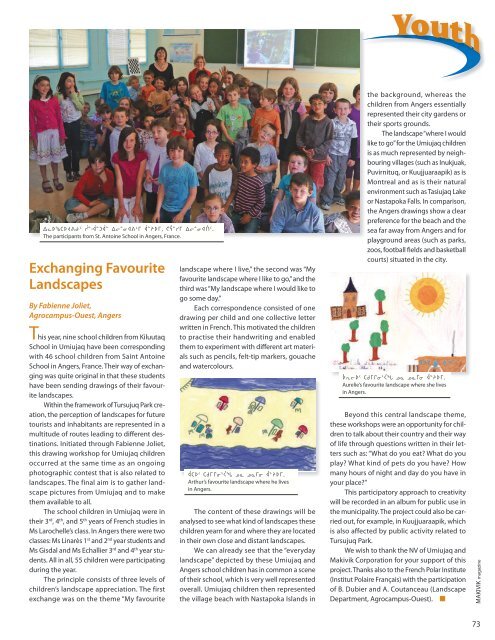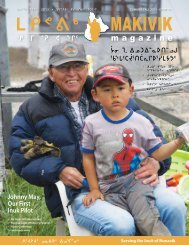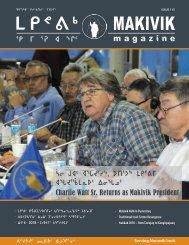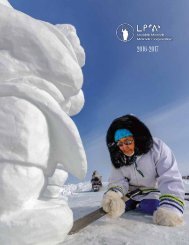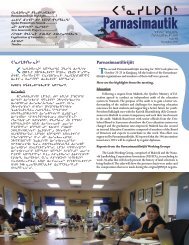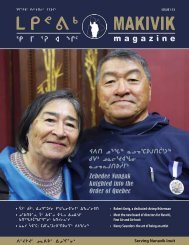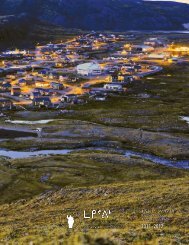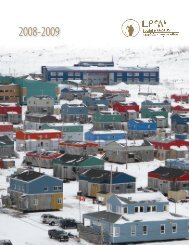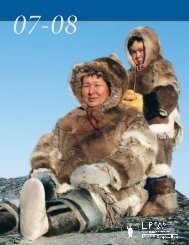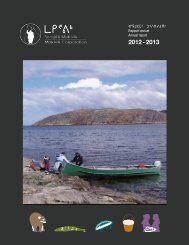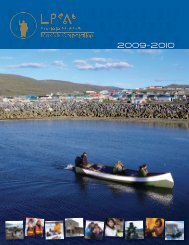Create successful ePaper yourself
Turn your PDF publications into a flip-book with our unique Google optimized e-Paper software.
wMscbsJ[î5 ¥8-€8g€8 wo8ix[7u €8psu, ?Ç8yu wo8ix†5.<br />
The participants from St. Antoine School in Angers, France.<br />
Exchanging Favourite<br />
Landscapes<br />
By Fabienne Joliet,<br />
Agrocampus-Ouest, Angers<br />
This year, nine school children from Kiluutaq<br />
School in Umiujaq have been corresponding<br />
with 46 school children from Saint Antoine<br />
School in Angers, France. Their way of exchanging<br />
was quite original in that these students<br />
have been sending drawings of their favourite<br />
landscapes.<br />
Within the framework of Tursujuq Park creation,<br />
the perception of landscapes for future<br />
tourists and inhabitants are represented in a<br />
multitude of routes leading to different destinations.<br />
Initiated through Fabienne Joliet,<br />
this drawing workshop for Umiujaq children<br />
occurred at the same time as an ongoing<br />
photographic contest that is also related to<br />
landscapes. The final aim is to gather landscape<br />
pictures from Umiujaq and to make<br />
them available to all.<br />
The school children in Umiujaq were in<br />
their 3 rd , 4 th , and 5 th years of French studies in<br />
Ms Larochelle’s class. In Angers there were two<br />
classes: Ms Linarès 1 st and 2 nd year students and<br />
Ms Gisdal and Ms Echallier 3 rd and 4 th year students.<br />
All in all, 55 children were participating<br />
during the year.<br />
The principle consists of three levels of<br />
children’s landscape appreciation. The first<br />
exchange was on the theme “My favourite<br />
landscape where I live,” the second was “My<br />
favourite landscape where I like to go,” and the<br />
third was “My landscape where I would like to<br />
go some day.”<br />
Each correspondence consisted of one<br />
drawing per child and one collective letter<br />
written in French. This motivated the children<br />
to practise their handwriting and enabled<br />
them to experiment with different art materials<br />
such as pencils, felt-tip markers, gouache<br />
and watercolours.<br />
€bs2 bfuQi3Ùz kN kNui €8psu.<br />
Arthur’s favourite landscape where he lives<br />
in Angers.<br />
The content of these drawings will be<br />
analysed to see what kind of landscapes these<br />
children yearn for and where they are located<br />
in their own close and distant landscapes.<br />
We can already see that the “everyday<br />
landscape” depicted by these Umiujaq and<br />
Angers school children has in common a scene<br />
of their school, which is very well represented<br />
overall. Umiujaq children then represented<br />
the village beach with Nastapoka Islands in<br />
the background, whereas the<br />
children from Angers essentially<br />
represented their city gardens or<br />
their sports grounds.<br />
The landscape “where I would<br />
like to go” for the Umiujaq children<br />
is as much represented by neighbouring<br />
villages (such as Inukjuak,<br />
Puvirnituq, or Kuujjuaraapik) as is<br />
Montreal and as is their natural<br />
environment such as Tasiujaq Lake<br />
or Nastapoka Falls. In comparison,<br />
the Angers drawings show a clear<br />
preference for the beach and the<br />
sea far away from Angers and for<br />
playground areas (such as parks,<br />
zoos, football fields and basketball<br />
courts) situated in the city.<br />
ßEos2 bfuQi3Ùz kN kNui €8psu.<br />
Aurelie’s favourite landscape where she lives<br />
in Angers.<br />
Beyond this central landscape theme,<br />
these workshops were an opportunity for children<br />
to talk about their country and their way<br />
of life through questions written in their letters<br />
such as: “What do you eat? What do you<br />
play? What kind of pets do you have? How<br />
many hours of night and day do you have in<br />
your place?”<br />
This participatory approach to creativity<br />
will be recorded in an album for public use in<br />
the municipality. The project could also be carried<br />
out, for example, in Kuujjuaraapik, which<br />
is also affected by public activity related to<br />
Tursujuq Park.<br />
We wish to thank the NV of Umiujaq and<br />
<strong>Makivik</strong> Corporation for your support of this<br />
project. Thanks also to the French Polar Institute<br />
(Institut Polaire Français) with the participation<br />
of B. Dubier and A. Coutanceau (Landscape<br />
Department, Agrocampus-Ouest).<br />
MAKIVIK mag a zine<br />
73


